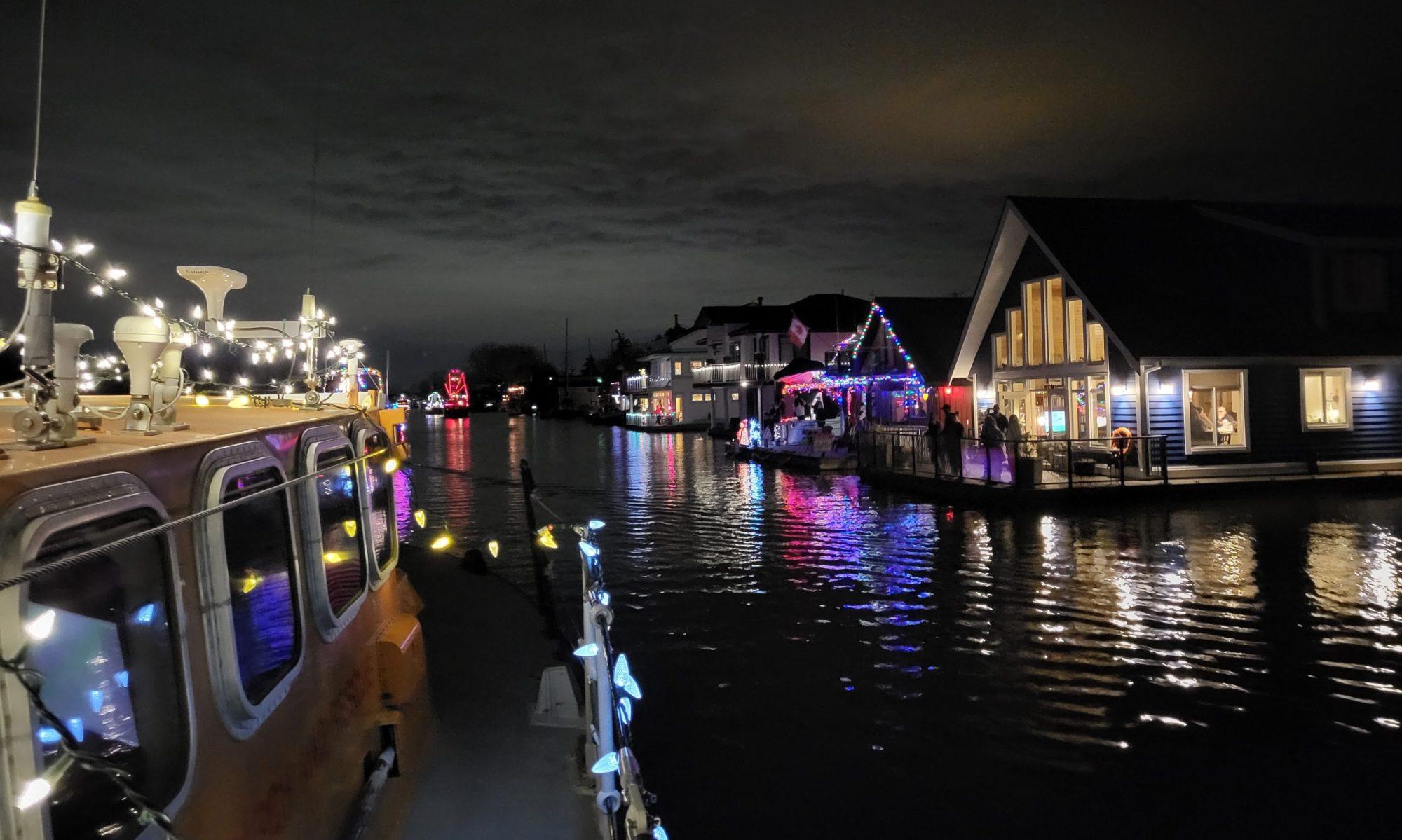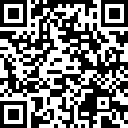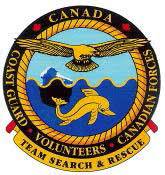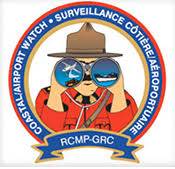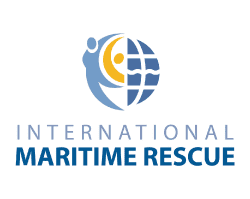Common to all CLI vessels
Both vessels are owned by the society and work in support of and in cooperation with local police, fire and rescue services, Port Authority, as well as with the Canadian Coast Guard, and RCM-SAR. Additionally, they participate in exercises and drills with Canadian Government vessels, as important resources for deployment in the event of civil emergencies.
The vessels and crews are part of the City of Delta’s emergency services programme, and many of our crew are registered with Emergency Management BC.
Our hull numbering is determined by society-owned [1] or privately owned [2] and whether self-righting [A] or non-self-righting [B].
Fraser Lifeboat 1A-04
The FRASER Lifeboat (formerly RNLI Famous Grouse) is based at the Steveston Lifeboat Station, 12551 No 1 Rd, Richmond, BC at the Fisheries and Oceans float. She serves under the flags of the CLI, and the City of Delta as required. Manned by an all-volunteer crew, she is often seen on patrol, ready to assist fishing, commercial, and recreational vessels experiencing difficulties.
Bought by the CLI in 2013, this vessel was introduced to the Royal National Lifeboat Institution (RNLI) in 1982 and entered service 2 years later. The Tyne class lifeboat was the RNLI’s first ‘fast’ slipway-launched lifeboat, which can also lie afloat. Her size was determined by the size of the existing boathouses. Features include a low-profile wheelhouse and a separate cabin behind the upper steering position.
The boat has a steel hull with a shallow draught, a long straight keel, and extended bilge keels to protect the propellers, all of which are necessary not only for slipway launching but also for working in shoal waters. Protection for the propellers is given by partial tunnels, very deep bilge keels port and starboard, and by a wide straight keel which ends in a hauling shoe used for winching the boat back into its house (if we had one).
The Tyne class is self-righting, aided by twin automatically inflating bags on the aft cabin roof (it should be noted that these have been disabled on the Fraser as getting them serviced in North America has proven difficult). The Tyne carries an X boat, a small unpowered and manually launched inflatable daughter boat, to access areas where the all-weather lifeboat cannot reach. The last Tyne was built in 1990.
In March 2017 the Fraser Lifeboat went through a series of electronic upgrades including all-new Raymarine touch screen systems and radar, Humminbird side-scan sonar, ICOM marine VHF radio upgrades, Class B AIS, VHF / UHF amateur radio installation, new batteries, engineering, and hull repaint where required. Old and obsolete equipment has been removed to save weight and modernize.
In 2018 over several months a new inverter and electrical system were run through the vessel. This now allows electrical functions while on shore power or at sea. LED bulbs were added to the nav and interior lights to increase intensity and longevity.
In May 2020 a new Fire Com intercom / radio link was added. The crew can also operate off-boat within 1500 ft of the Fraser Lifeboat. This is a vast improvement in safety as well as command, control, and communications. AIS display was also added to the Humminbird side scan sonar system.
In November 2020 a Furuno radar was added. The system ties in with Nobeltec TIMEZERO Professional and allows weather info and planning thus enhancing situational awareness.
In December 2023 a new Garmin Satellite Compass was added to connect to the vessel’s computer, as well as a weather station installed, new search and rescue life-jackets with safety lanyards, and a line launcher were added to our equipment.
In Feb 2025, a new Class A AIS was installed to enhance safety. A towing light was added. A new anchor was added bringing the vessel’s total to 3 different types. Also, a 4-way camera system with a data recorder was added to increase safety and situational awareness.
A brief history of the Tyne class ‘Fraser Lifeboat’
|
|
| Built |
Fairy Marine, Cowes Shipyard in 1987, UK |
| Ex RNLI Official Number |
1133 (47-021) |
| Original Name |
Famous Grouse |
| Original Callsign |
GIAD |
| First Commissioned |
1987 |
| Hull |
Corten steel, Shallow draft |
| Superstructure |
Watertight aluminium |
| Length Overall |
14.320 m (46.98 ft.) |
| Length Datum |
13.000 m (42.65 ft.) |
| Beam Overall |
4.572 m (15 ft.) |
| Beam Moulded |
4.267 m (14 ft.) |
| Wheelhouse top |
3.962 m (13.00 ft. above keel) |
| Draught Aft |
1.400 m (4.60 ft.) |
| Displacement limited to |
24.385 tonnes (24.00 tons) |
| Engines |
2 × Detroit GM 6V92 TA diesel 425 Shp (317 kW) at 2,300 rpm |
| Rudders |
Twin power-assisted and hand hydraulic-controlled |
| Speed |
17.6 knots (20.25 mph; 32.59 km/h) |
| Crew |
Average 6-8 (Min 2) |
| Range |
240 nm (444.48 km) |
| Fuel Tank Capacity |
Port Tank 1318 litres (289.96 gallons)
STB Tank 1318 litres (289.96 gallons)
Reserve Tank 463.70 litres (102 gallons) |
| Fresh Water |
45.46 litres 10 gallons 2 x Jerry Cans |
| Self-right |
Five seconds
Capacity: 37 persons |
| Non-Self Righting Cap |
108 persons |
| Additional Equipment |
Class A AIS, Raymarine and Furuno radars, VHF x 5, PA x 2, amateur radio, chart plotter, side-scan sonar, Fire Com intercom / radio link, 3 x high-intensity searchlights, portable salvage / firefighting pump, engine driven salvage / firefighting pump, portable generator, first aid, oxygen, AED, line launcher, weather station, satellite compass, and 4 external video cameras with recorder. |
Delta Lifeboat 1B-02
The Delta Lifeboat has a long history of service in the maritime community. Designed by the US Navy as an Admiral’s Barge, and reportedly used by Admiral Nimitz as his launch at one time, it was built in 1944 in Pearl Harbour, Hawaii. Following naval service transporting flag officers moving between warships, she passed into private hands and was modified for use as a recreational vessel.
Previously known as Artist’s Life, in 1988 this classic wooden vessel was purchased by marine artist and official Canadian naval war artist, John Horton and renamed Steveston Lifeboat. This began her life-saving career, and she was updated for Maritime Search and Rescue. Changes ensured she was a secure platform for working alongside vessels in distress, and that she could safely undertake towing tasks; all while providing a safe environment for crew members during patrol and call-out activities. For many years she operated out of Steveston Harbour, working in support of the fishing industry in the Fraser Estuary and Gulf of Georgia.
While still registered as the Steveston Lifeboat, major repair and refit activities were completed in 2017. These included an update of navigation and communications equipment, a complete overhaul of the engine and related equipment, and minor structural changes to provide additional working space on the bridge.
The vessel is based in Ladner Harbour at the Ladner Lifeboat Station, 4850 McNeely’s Way, Delta, BC and was renamed Delta Lifeboat. She serves under the flags of the CLI and the City of Delta. Manned by an all-volunteer crew, she is often seen on patrol, ready to assist fishing, commercial, and recreational vessels experiencing difficulties.
In Sep 2020, the Delta Lifeboat was graciously donated to the CLI by John and Mary Horton. The vessel was renumbered at that time from 2B to 1B.
In Dec 2023 the vessel received further wood replacement and the installation of a holding tank was completed. A line launcher was also added to the equipment.
In May 2024 DELTA Lifeboat had further wood replaced, as long as some mechanical issues worked on. The vessel underwent a complete sanding and repaint from top to bottom.
In 2025 a complete sand down and full repaint of the vessel top side was undertaken, other maintenance tasks were all performed during refit.
A brief history of the ‘Delta Lifeboat’
| New Owner 2020 |
Canadian Lifeboat Institution |
| Built |
U.S. Navy, Pearl Harbour, Hawaii, USA |
| CLI Official Number |
1B-02 (previously 2B-02) |
| Entered CLI Service |
1994 |
| Call Sign |
VOQQ |
| Previous Name(s) |
Artist’s Life, Steveston Lifeboat |
| First Commissioned |
1944 |
| Hull |
Wood |
| Superstructure |
Wood, fiberglass, and aluminum |
| Design |
U.S. Navy general service hull configured as an admiral’s barge |
| Length Overall |
15.8 m (52 ft.) |
| Beam |
4.26m (12 ft. 8 in) |
| Draft |
1.52m (5 ft.) |
| Displacement |
29 tons |
| Engine |
1 x Detroit GM 671 diesel 157 Shp x 1,800 rpm |
| Rudder |
1 |
| Top Speed |
10 knots on a single 4-blade prop |
| Crew |
Min 3, Max 9 |
| Max Survivor Capacity |
160 persons |
| Range |
1,000 nm on 2800 liter fuel capacity |
| Additional Equipment |
Class A AIS, radar x 2, VHF x 4, chart plotter, 3 x searchlights, portable salvage / firefighting pump, firefighting foam, crew support facilities for extended periods, first aid, oxygen, AED, weather station, and line launcher. |
| RHIB (CLI Y-02) |
10.5 ft, powered |
